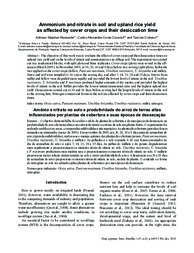Ammonium and nitrate in soil and upland rice yield as affected by cover crops and their desiccation time.
Ammonium and nitrate in soil and upland rice yield as affected by cover crops and their desiccation time.
Authorship: NASCENTE, A. S.; CRUSCIOL, C. A. C.; COBUCCI, T.
Summary: The objective of this work was to evaluate the effect of cover crops and their desiccation times on upland rice yield and on the levels of nitrate and ammonium in a no.tillage soil. The experiment was carried out in a randomized blocks, with split plots and three replicates. Cover crops (plots) were sowed in the off season (March 2009). In November 2009, at 30, 20, 10 and 0 days before rice sowing (split plots), herbicide was applied on the cover crops (fallow, Panicum maximum, Urochloa ruziziensis, U. brizantha and millet). Straw and soil were sampled (0.10 cm) at the sowing day, and after 7, 14, 21, 28 and 35 days. Straws from millet and fallow were degraded more rapidly and provided the lowest level of nitrate in the soil. Urochloa ruziziensis, U. brizantha and P. maximum produced higher amounts of dry matter, and provided the highest levels of nitrate in the soil. Millet provides the lowest nitrate/ammonium ratio and the highest upland rice yield. Desiccations carried out at 30 and 20 days before sowing had the largest levels of nitrate in the soil at the sowing date. Nitrogen content and forms in the soil are affected by cover crops and their desiccation times.
Publication year: 2012
Types of publication: Journal article
Unit: Embrapa Rice & Beans
Observation
Some of Embrapa's publications are published as ePub files. To read them, use or download one of the following free software options to your computer or mobile device. Android: Google Play Books; IOS: iBooks; Windows and Linux: Calibre.
Access other publications
Access the Agricultural Research Database (BDPA) to consult Embrapa's full library collection and records.
Visit Embrapa Bookstore to purchase books and other publications sold by Embrapa.

